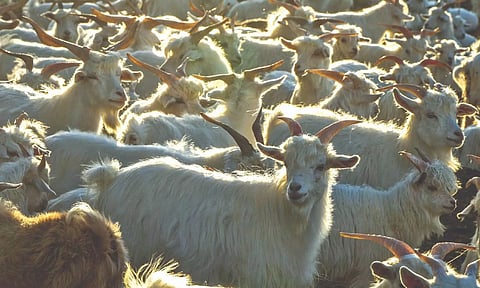

By Ginger Allington
NEW YORK: A decade or more ago, it wasn’t uncommon to pay several hundred dollars for a cashmere sweater. Now, as the holiday season approaches, advertisements offer cashmere sweaters at less than half that price.
An ad campaign on Instagram from the retailer Quince boasts, “This $50 cashmere sweater is worth the hype!” A cozy cashmere sweater at a bargain price may seem like a win for consumers. But it comes at a steep cost to one of our most fragile environmental systems — the grasslands of the Mongolian Plateau in Central Asia.
Every cashmere sweater begins with a goat. The fibers are woven from the soft downy undercoat of several breeds. These days, most cashmere fiber comes from the cold, arid steppes of China and Mongolia — a pastureland of immense size and scale, about a million square miles, where for centuries seminomadic herders have raised sheep, horses, yaks, camels, and other livestock.
Demand for cashmere has grown so much that goats have become the dominant animal in many herds.
As a scientist who visits and studies the Mongolian Plateau, I have witnessed the toll that expanding herds of cashmere goats have had on the environment. Goats are much more destructive than other livestock to grassland ecosystems, like those of the Central Asian steppe.
Whereas sheep nibble the tops of grasses but leave the base and roots intact, goats eat plants down to the roots so they cannot regrow, degrading habitat and causing soil erosion.
These grasslands are particularly difficult to restore once the vegetation is removed and soils are damaged; in the most heavily impaired areas, grasses are displaced by shrubs and sand.
An estimated 27.5 million goats graze the grasslands of Mongolia (the government does not distinguish between cashmere and non-cashmere goats, but cashmere goats predominate); in the Inner Mongolia region of China, the overall number is about 15 million.
A 2018 national report on Mongolia’s rangeland found that nearly 58 percent had been degraded to various degrees from grazing as of 2016, with 23 percent classified as either heavily or fully degraded.
Goats that graze on rangelands in poor condition produce shorter, thicker fibers that fetch lower prices in the market, forcing some herders to increase their herd sizes to make ends meet.
Manufacturers use these subpar fibers to create the affordable cashmere sweaters that are now a staple of the holiday shopping season.
These garments fall short in terms of durability compared with those made from high-quality wool.
The very essence of what makes cashmere luxurious — softness, warmth, and longevity — is compromised, at a huge environmental cost.
Even so, retailers are marketing cashmere by tapping into consumer desire for eco-conscious products, with sales pitches like “100 percent Inner Mongolian two-ply cashmere.” By labelling garments this way, retailers no doubt hope consumers will assume that the sourcing of this cashmere equates to quality, but the overture is essentially meaningless. Most cashmere comes from that region anyway, and it is difficult to validate claims of sustainability.